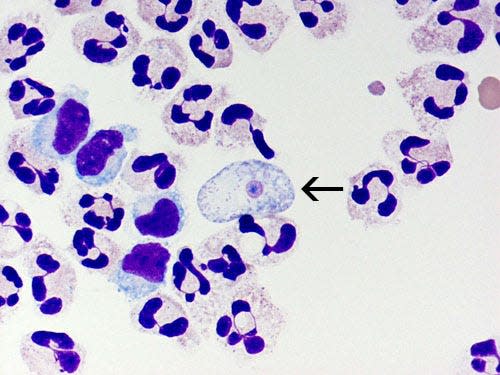Scrub Hub: Is the brain-eating amoeba expanding its range north into Indiana and Midwest?
It sounds like something out of a science-fiction film: Naegleria fowleri. And in a way, it is.
More commonly, it's called the brain-eating amoeba.
It infects people when water containing the organism enters the body through the nose, such as when people are swimming or diving. The amoeba then travels up the nose and to the brain, where it destroys the brain tissue, according to the U.S. Centers for Disease Control and Prevention.
Infections from this bacteria are rare ― a total of 29 cases were reported across the U.S. in the last decade ― but they are almost always fatal. And they are spreading.
Scrub Hub: What are the risks of algal blooms and how does my family stay safe?
Typically, Midwesterners might think of brain-eating infections as a southern thing. While that might have been in the case in the past, new research is raising questions about it's growing footprint. For this edition of the Scrub Hub, we are looking at the question: Is the brain-eating amoeba expanding to the north? And why?
To find the answers, we looked at information from the CDC as well as a recently-released report on the amoeba and how it's changing.

Where do you find the brain-eating amoeba?
When it comes to water, it's almost easier to say where this amoeba can't be found: salt water, like the ocean. Other than that, it lives in warm freshwater around the world.
According to the CDC, it can be present in any freshwater body in the U.S. ― regardless of state ― and especially during warmer summer months. It's a heat-loving organism and grows best at hotter temperatures. Through tests of water bodies linked to infections, scientists have found the water temperatures have typically been higher than 80 degrees Fahrenheit. Still, it is possible the amoeba may live in water with temperatures below that.
It can live in all sorts environments, including lakes and rivers where it is mostly likely to come in contact with people. It also can be found in hot springs and soil at the bottom of ponds and other water bodies. It even can live in swimming pools, splash pads and other recreational venues that don't have enough chlorine or are poorly maintained.
Is the amoeba's footprint expanding?
Infections of the brain-eating amoeba have primarily been focused in the southern states ― where temperatures are higher and the waters naturally are a bit warmer. Waters farther north often don't reach the temperatures that the amoeba prefers.
But that has been changing.
Climate change ― which has been causing milder winters overall and hotter summers ― is helping the brain-eating organism to expand its range northward. The drought conditions that states like Indiana and others also have seen in the summers causes water levels to drop, creating a happy environment for the parasite to thrive.
This is similar to the spread of ticks as weather patterns and the climate continues to change.
In fact, this trend spurred the Ohio Public Health Association to publish a case report raising awareness of the disease among health care providers in the state.
"Increased incidence of N. fowleri [a species of brain-eating amoeba] in northern climates is but one of many ways climate change threatens human health and merits novel education of health care providers," the report authors wrote in a paper published May 16 in the Ohio Journal of Public Health.
Most infections have previously been linked to the south, particularly Florida and Texas. Since 2010, however, cases have started to occur in the Midwest including states such as Iowa and Kansas and as far north as Minnesota. There even has been incidence of infections right here in Indiana.
In 2012, the parasite infected a man teaching his daughter to swim in a southwestern Indiana lake. He died within weeks. Last summer, the amoeba is believed to have caused two deaths in the Midwest.

Symptoms of the brain-eating amoeba present very similarly to those of bacterial meningitis, according to the CDC. In the first few days, those infected my experience headache, fever, nausea or vomiting. As the disease progresses, symptoms can include stiff neck, confusion, seizures, hallucinations and coma.
The death rate for someone who has been infected is over 97%. Because infections are so rare, and it progresses so quickly, effective treatments have been challenging to identify, the CDC says. Still, research continues to work on this topic.
Unfortunately, there is no way for swimmers and boaters to tell if the organism is there. It's naturally occurring in freshwater. It's so small it can be seen only under a microscope. And there is no rapid test for it, it can take weeks to identify the amoeba in a waterbody.
Scrub Hub: Why should I consider using rain barrels at my home?
While the risk of infection is rare, the CDC recommends focusing on preventing water from going up the nose. The agency also said that the amoeba are more likely to live in the sediment at the bottom of lakes, ponds or rivers, so swimmers should avoid digging or stirring up the soil.
The CDC said that people should seek medical care immediately whenever they develop a sudden onset of fever, headache, vomiting, or stiff neck, particularly if they have been in warm fresh water recently.
If you have more questions about climate and pests, or any other topics, let us know! You can ask us by submitting a question through our Google form below.
Can’t see the form? Click here.
Connect with IndyStar’s environmental reporters: Join The Scrub on Facebook.
IndyStar's environmental reporting project is made possible through the generous support of the nonprofit Nina Mason Pulliam Charitable Trust.
This article originally appeared on Indianapolis Star: Brain-eating amoeba expanding its range northward with climate change
